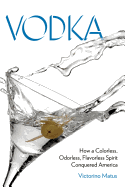
Victorino Matus, a senior editor at the Weekly Standard, presents a crisp and highly intoxicating account of how vodka--a spirit "without distinctive character, aroma, taste or color"--conquered the West, replaced gin and vermouth as the cocktail mixer of choice and spawned a billion-dollar industry.
Vodka ("little water" in Russian) began as a smelly, bad-tasting medicinal liquid introduced by a 15th-century Russian monk. If Pyotr Smirnoff had not isolated its pure form centuries later and marketed it worldwide, vodka might never have taken off. The spirit's popularity soared with the introduction of the Bloody Mary as the "hangover cure" and James Bond's "shaken, not stirred" martinis. Soon, vodka replaced gin as America's colorless spirit of choice. But it wasn't until Swedish distillery Absolut appeared with its clever "Absolut Perfection" ad campaign that vodka achieved its iconic heights. Entrepreneurs inspired to seek a piece of the action tested the market with premium brands and craft spin-offs; short production times made vodka's economic reach more immediate.
Though Americans drink more vodka than any other spirit, the liquor itself has received a mixed welcome among experts. Cocktail historian David Embrey went so far as to call it "a wholly characterless, dilute grain alcohol that has streaked across the firmament of mixed drinks like Halley's Comet." Some liken the use of flavored vodkas to "making paella with instant rice." Still, the country's love affair with the spirit continues. What does this say about American palates? Readers may just find themselves reaching for that bottle of Grey Goose in order to prove the snarky experts wrong. --Nancy Powell, freelance writer and technical consultant

